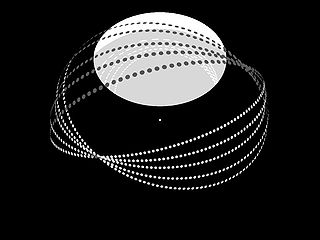Lincos is a constructed language first described in 1960 by Dr. Hans Freudenthal in his book Lincos: Design of a Language for Cosmic Intercourse, Part 1. It is a language designed to be understandable by any possible intelligent extraterrestrial life form, for use in interstellar radio transmissions. Freudenthal considered that such a language should be easily understood by beings not acquainted with any Earthling syntax or language. Lincos was designed to be capable of encapsulating "the whole bulk of our knowledge".
The search for extraterrestrial intelligence (SETI) is a collective term for scientific searches for intelligent extraterrestrial life, for example, monitoring electromagnetic radiation for signs of transmissions from civilizations on other planets.

The Bussard ramjet is a theoretical method of spacecraft propulsion for interstellar travel. A fast moving spacecraft scoops up hydrogen from the interstellar medium using an enormous funnel-shaped magnetic field ; the hydrogen is compressed until thermonuclear fusion occurs, which provides thrust to counter the drag created by the funnel and energy to power the magnetic field. The Bussard ramjet can thus be seen as a ramjet variant of a fusion rocket.

A generation ship, generation starship or world ship, is a hypothetical type of interstellar ark starship that travels at sub-light speed. Since such a ship might require hundreds to thousands of years to reach nearby stars, the original occupants of a generation ship would grow old and die, leaving their descendants to continue traveling.

The communication with extraterrestrial intelligence (CETI) is a branch of the search for extraterrestrial intelligence (SETI) that focuses on composing and deciphering interstellar messages that theoretically could be understood by another technological civilization. The best-known CETI experiment of its kind was the 1974 Arecibo message composed by Frank Drake.

Stellar engines are a class of hypothetical megastructures which use the resources of a star to generate available work. For instance, they can use the energy of the star to produce mechanical, electrical or chemical work or they can use the impulse of the light emitted by the star to produce thrust, able to control the motion of a star system. The concept has been introduced by Bădescu and Cathcart. The variants which produce thrust may accelerate a star and anything orbiting it in a given direction. The creation of such a system would make its builders a type-II civilization on the Kardashev scale.

A Bracewell probe is a hypothetical concept for an autonomous interstellar space probe dispatched for the express purpose of communication with one or more alien civilizations. It was proposed by Ronald N. Bracewell in a 1960 paper, as an alternative to interstellar radio communication between widely separated civilizations.
Astrolinguistics is a field of linguistics connected with the search for extraterrestrial intelligence (SETI).
The San Marino Scale is a suggested scale for assessing risks associated with deliberate transmissions from Earth aimed to possible extraterrestrial intelligent life. The scale evaluates the significance of transmissions from Earth as a function of signal intensity and information content. The scale was suggested by Iván Almár at a conference in San Marino in 2005. The radio output of Jupiter, Saturn and Neptune is not considered in the model. The San Marino Scale was subsequently adopted by the SETI Permanent Study Group of the International Academy of Astronautics at its 2007 meeting in Hyderabad, India.
Active SETI is the attempt to send messages to intelligent extraterrestrial life. Active SETI messages are predominantly sent in the form of radio signals. Physical messages like that of the Pioneer plaque may also be considered an active SETI message. Active SETI is also known as METI.

Acta Astronautica is a monthly peer-reviewed scientific journal covering all fields of physical, engineering, life, and social sciences related to the peaceful scientific exploration of space. The journal is widely known as one of the top aerospace engineering journals. The journal was established in 1955 under the name Astronautica Acta, obtaining its current title in 1974, with volume-numbering simultaneously restarting at 1. The journal is published by Elsevier, sponsored by the International Academy of Astronautics.
The cultural impact of extraterrestrial contact is the corpus of changes to terrestrial science, technology, religion, politics, and ecosystems resulting from contact with an extraterrestrial civilization. This concept is closely related to the search for extraterrestrial intelligence (SETI), which attempts to locate intelligent life as opposed to analyzing the implications of contact with that life.

The Galactic cloud, G cloud, G-Cloud or G-Cloud complex, is an interstellar cloud located next to the Local Interstellar Cloud, within the Local Bubble. It is unknown whether the Solar System is embedded in the Local Interstellar Cloud or in the region where the two clouds are interacting, although the Solar System is currently moving towards the G-Cloud. The G-Cloud contains the stars Alpha Centauri and Altair.
The Initiative for Interstellar Studies (i4is) is a UK-registered not-for-profit company, whose objectives are education and research into the challenges of Interstellar Travel. It pioneered small-scale laser sail interstellar probes and missions to interstellar objects. Several of its principals were involved in the 100 Year Starship winning team originated by NASA and DARPA.

Technosignature or technomarker is any measurable property or effect that provides scientific evidence of past or present technology. Technosignatures are analogous to biosignatures, which signal the presence of life, whether intelligent or not. Some authors prefer to exclude radio transmissions from the definition, but such restrictive usage is not widespread. Jill Tarter has proposed that the search for extraterrestrial intelligence (SETI) be renamed "the search for technosignatures". Various types of technosignatures, such as radiation leakage from megascale astroengineering installations such as Dyson spheres, the light from an extraterrestrial ecumenopolis, or Shkadov thrusters with the power to alter the orbits of stars around the Galactic Center, may be detectable with hypertelescopes. Some examples of technosignatures are described in Paul Davies's 2010 book The Eerie Silence, although the terms "technosignature" and "technomarker" do not appear in the book.
Atmosphere-breathing electric propulsion, or air-breathing electric propulsion, shortly ABEP, is a propulsion technology for spacecraft, which could allow thrust generation in low orbits without the need of on-board propellant, by using residual gases in the atmosphere as propellant. Atmosphere-breathing electric propulsion could make a new class of long-lived, low-orbiting missions feasible.
Project Lyra is a feasibility study of a mission to interstellar objects such as ʻOumuamua and 2I/Borisov, initiated on 30 October 2017 by the Initiative for Interstellar Studies (i4is). In January 2022, researchers proposed that a spacecraft launched from Earth could catch up to 'Oumuamua in 26 years for further close-up studies.

Douglas A. Vakoch is an American astrobiologist, search for extraterrestrial intelligence (SETI) researcher, psychologist, and president of METI International, a nonprofit research and educational organization devoted to transmitting intentional signals to extraterrestrial civilizations. Vakoch led METI's participation in Sónar Calling GJ 273b, which transmitted a series of interstellar messages to Luyten's Star, located 12.4 light years from Earth. Vakoch advocates ongoing transmission projects, arguing that this does not increase risks of an alien invasion as suggested by British cosmologist Stephen Hawking. He has participated in several SETI observation programs, and after sixteen years at the SETI Institute, where he was director of Interstellar Message Composition, Vakoch founded METI International. He has edited over a dozen books in SETI, astrobiology, the psychology of space exploration, and ecocriticism. He is general editor of two-book series in ecocriticism and in the intersection of space and society. Vakoch has appeared widely on television and radio as a commentator on SETI and astrobiology. He is an emeritus professor of clinical psychology at the California Institute of Integral Studies (CIIS).

Calathus is a proposed student-designed Ceres sample-return mission, that would consist of an orbiter and a lander with an ascent module. The orbiter would be equipped with a camera, a thermal imager, and a radar; the lander will have a sampling arm, a camera, and a gas chromatograph mass spectrometer. Mission objective is to return maximum 40 grams (1.4 oz) of Ceresian soil. The mission was designed and proposed in 2018 with support of ESA.

Rendezvous with the Future is a documentary series commissioned by Bilibili and produced by BBC Studios which explores the science behind the science fiction of author Liu Cixin. The series premiered in China on 16 November 2022 and has been watched by a combined audience of more than 80 million.











